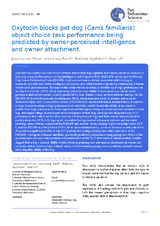Mostrar el registro sencillo del ítem
Oxytocin blocks pet dog (Canis familiaris) object choice task performance being predicted by owner-perceived intelligence and owner attachment
| dc.contributor.author | Oliva, Jessica Lee | |
| dc.contributor.author | Rault, Jean-Loup | |
| dc.contributor.author | Appleton, Belinda | |
| dc.contributor.author | Lill, Alan | |
| dc.date.accessioned | 2016-04-15T09:32:36Z | |
| dc.date.available | 2016-04-15T09:32:36Z | |
| dc.date.issued | 2016 | |
| dc.identifier.issn | 2445-2874 | |
| dc.identifier.uri | http://hdl.handle.net/10396/13422 | |
| dc.description.abstract | A positive association has been found between owner-rated dog cognition and owner-perceived closeness to their dog, using the Perceptions of Dog Intelligence and Cognitive Skills (PoDIaCS) survey and the Monash Dog Owner Relationship Scale (MDORS). Oxytocin has been positively associated with bonding in mammals and with non-verbal intelligence in humans and could therefore explain this relationship between owner-rated questionnaires. The aims of this study were to ascertain: i) whether a pet dog’s performance on an object choice task (OCT), which objectively measures dogs’ ability to use human non-verbal, social gestures to find a food reward, could be predicted by their owners’ scores on three different surveys: (a) the MDORS, (b) the Pet Attachment Questionnaire (PAQ), which measures levels of anxious and avoidant attachment styles, and (c) a modified version of the PoDIaCS, and ii) if intranasal administration of oxytocin to dogs, known to enhance dogs’ performance on such tasks, would disable the ability of an owner to predict their dogs’ performance. It was hypothesized that higher ratings of owner-reported closeness to their dog, and higher ratings of owner-perceived intelligence of their dog, would positively predict dog OCT performance after saline, but not after oxytocin. Seventy-five pet dogs and their owners were recruited to participate in two OCTs, 5-15 days apart, once after the dog received intranasal oxytocin and once after receiving saline. Owners completed the PoDIaCS and another survey relating to pet ownership before OCT 1, and the MDORS and PAQ before OCT 2. After saline administration, scores on the anxious subscale of the PAQ were a negative predictor of dog OCT performance using pointing cues, while subscale 6 of the PoDIaCS, ‘contagion of human emotions’, positively predicted performance using gazing cues. None of the questionnaire subscales were predictive of performance on the OCT after oxytocin administration. Results suggest that a dog’s ‘natural’ ability to follow human pointing cues and anxious attachment in owners are inversely related, whilst a dog’s ‘natural’ ability to follow human gazing cues is positively related to ownerrated empathic ability of the dog. | es_ES |
| dc.format.mimetype | application/pdf | es_ES |
| dc.language.iso | eng | es_ES |
| dc.publisher | Universidad de Córdoba, Departamento de Medicina y Cirugía Animal | es_ES |
| dc.rights | https://creativecommons.org/licenses/by-nc-sa/4.0/ | es_ES |
| dc.source | Pet Behaviour Science 1, 31-46 (2016) | es_ES |
| dc.subject | Attachment | es_ES |
| dc.subject | Bonding | es_ES |
| dc.subject | Dogs | es_ES |
| dc.subject | Owner | es_ES |
| dc.subject | Oxytocin | es_ES |
| dc.title | Oxytocin blocks pet dog (Canis familiaris) object choice task performance being predicted by owner-perceived intelligence and owner attachment | es_ES |
| dc.type | info:eu-repo/semantics/article | es_ES |
| dc.relation.publisherversion | http://www.uco.es/ucopress/ojs/index.php/pet/index | es_ES |
| dc.rights.accessRights | info:eu-repo/semantics/openAccess | es_ES |

